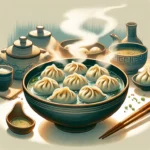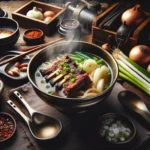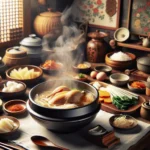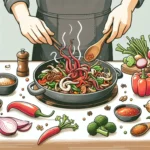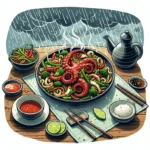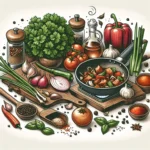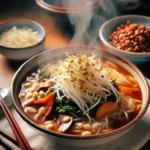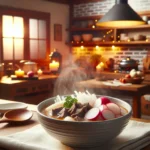Imagine walking through a bustling Korean market, the aroma of savory broth and tender pork wafting through the air. This is the essence of Dwaeji Gukbap, a comforting pork and rice soup that tells a story with every slurp. Have you ever wondered how to recreate this authentic experience in your own kitchen? With the right ingredients and a little finesse, you can transform your dining table into a culinary journey to Korea. Join me as we explore the intricacies of this beloved dish, discover the secrets to perfecting its flavor, and enjoy serving suggestions that will elevate your meal to new heights. It’s time to embrace the heartwarming spirit of Dwaeji Gukbap!

Ingredients Needed for Dwaeji Gukbap
Creating an authentic Dwaeji Gukbap requires a careful selection of ingredients that not only develop the dish’s signature flavor but also provide a unique and satisfying experience. To embark on this culinary adventure, gather the following essential components:
Main Ingredients
- Pork: The star of the show! You will need approximately 500 grams of fresh pork belly or neck. These cuts are ideal due to their rich marbling, which contributes a succulent, juicy texture to the soup. Don’t shy away from a bit of fat; it enhances the overall flavor profile!
- Rice: About 1 cup of short-grain rice is what you seek. This type of rice is crucial for achieving that nice, sticky texture that so elegantly clings to each bite of the tender pork. Rinse it well before cooking to remove excess starch – this will refine the texture of your soup!
- Broth: The foundation of any great soup is a delightful broth. Prepare about 6 cups of water, preferably using pork bones to infuse a deeper flavor. Alternatively, you might use a store-bought broth, but homemade is where the magic happens! 😊
- Aromatics: You will need 1 medium onion, sliced, and 2-3 cloves of garlic, minced. These two will uplift the flavor and round out the hearty qualities of the soup. The aroma will be simply irresistible!
- Vegetables: For additional depth and nutrition, chop up 1 carrot and 1 zucchini. These colorful veggies not only make the dish visually appealing but also add a slight sweetness and crunch that contrasts beautifully with the tender pork.
- Seasoning: This is where flavors come to life! Include 2-3 tablespoons of Korean soy sauce (perhaps a mix of light and dark for complexity) and 1-2 tablespoons of sesame oil for that nutty aroma. You can also add salt to taste. Don’t forget a sprinkle of black pepper for that hint of spice. If you’re feeling adventurous, consider adding a little bit of gochugaru (Korean chili flakes) for a touch of heat!
- Herbs: A few springs of green onions (about 2-3), finely chopped, will do wonders for garnishing your dish at the end. Additionally, if you like a hint of freshness, some minced coriander or perilla leaves can be thrown in before serving.
- Optional Add-ins: Depending on your taste, you may want to include additional ingredients like mushrooms (shiitake or enoki work well) or even tofu for added protein!
The key to an unforgettable Dwaeji Gukbap lies not only in the quality of your ingredients but also in their preparation. Using fresh and locally sourced items where possible will definitely elevate your dish to the next level. Cooking is an art, and with these carefully selected ingredients, you are well on your way to mastering this classic Korean comfort food! 🍚🥘
As you gather your ingredients and begin to visualize the rich flavors and tantalizing aromas filling your kitchen, remember that the journey of cooking Dwaeji Gukbap is just as enjoyable as savoring the final bowl. Prepare with love, and your stunning creation will surely warm the hearts and bellies of all who are fortunate enough to indulge!
Step-by-Step Cooking Instructions
To create a comforting bowl of Dwaeji Gukbap, the authentic Korean pork and rice soup, a systematic approach is essential. Follow these meticulously outlined steps to achieve the perfect flavor and texture! 🍲✨
Preparation of Ingredients
Begin this culinary journey by gathering all the essential ingredients. You will need about 500 grams of pork neck or belly (sliced thin for faster cooking), 1 cup of short-grain rice, 1 medium-sized onion (diced), 2-3 cloves of garlic (minced), and 4-6 cups of water or broth. Additionally, soy sauce (2 tablespoons), sesame oil (1 tablespoon), and salt (to taste) are crucial for flavor enhancement. Don’t forget about the optional garnishes like green onions and sesame seeds to add that final touch! 🥢
Rinsing the Rice
Rinsing the rice is an often-overlooked step, but it’s vital for removing excess starch! Take the short-grain rice and wash it under cold running water until the water runs clear. This method not only ensures a better texture but also prevents the soup from becoming too cloudy!
Cooking the Pork
In a heavy-bottomed pot, heat a tablespoon of sesame oil on medium-high heat. Once the oil shimmers, add the diced onion and minced garlic, sautéing them for about 2-3 minutes until fragrant. Then, introduce the pork slices to the pot! Stir-fry them for another 5-7 minutes until they begin to brown—this is where the deep flavors develop!
Adding Water and Seasoning
Pour in 4-6 cups of water or broth, stirring to combine the ingredients. Bring the mixture to a boil, then reduce the heat to a simmer. Add 2 tablespoons of soy sauce and season with salt. This blend of salty and savory notes is what makes Dwaeji Gukbap irresistibly scrumptious!
Simmering the Soup
Allow the soup to simmer gently for about 30-40 minutes. During this time, the pork will become tender and the flavors will meld beautifully. For a richer flavor profile, consider skimming off any scum that forms on the surface. You want a clean, clear broth!
Cooking the Rice
While the soup simmers, it’s the perfect time to prepare the rice. If you have ready-to-use cooked rice, great! If not, you can cook the rinsed rice in a separate pot. Use the standard rice-to-water ratio, generally 1 cup of rice to 1.5 cups of water, and bring it to a boil before reducing to a simmer. This should take about 15-20 minutes.
Bringing It All Together
As the timer goes off for both the soup and the rice, combine them. Add the cooked rice directly into the pot of simmering soup! Stir well and let it cook for an additional 5 minutes to allow the rice to soak up the delicious broth.
Final Adjustments
Taste your creation! This is an opportunity to adjust the seasoning to your liking. Add more soy sauce or salt if necessary. Don’t hesitate to sprinkle in some freshly chopped green onions for that vibrant finish! 🌿
Serving
Once everything is perfectly seasoned, ladle the soup into bowls and top with sesame seeds and additional green onions for garnish. Serve hot and enjoy the delightful flavors of Korea right in your home! 🍚🥄
Mastering these step-by-step instructions will allow you to create a bowl of Dwaeji Gukbap that’s not only delicious but also heartfelt—perfect for sharing with loved ones. 🍽️😋
Tips for Achieving the Perfect Flavor
Creating an authentic Dwaeji Gukbap that makes your taste buds dance with joy is an art that involves understanding and balancing flavors perfectly. Here are some essential tips to elevate your pork and rice soup to a heavenly experience!
1. Quality of Ingredients Matters!
Start with high-quality pork shoulder or belly – around 2 pounds is ideal! The marbling in well-cut pork contributes to a rich flavor that forms the backbone of the dish. Organic options, if available, provide an even deeper taste, ensuring your broth is the best it can be. Additionally, fresh vegetables like onion, garlic, and green onions are your best friends! They should be robust and vibrant.
2. Rinse Your Rice Thoroughly!
Did you know? The way you prepare your rice can significantly influence the broth’s clarity and taste. Rinse about 1 cup of short-grain rice until the water runs clear. This step not only removes excess starch but also prevents the soup from becoming too gloopy. Once rinsed, soak it in water for at least 30 minutes before cooking – this will help your rice achieve that perfect texture! 🍚
3. Sauté for Depth of Flavor!
Don’t underestimate the power of fragrant aromatics. Start by sautéing a tablespoon of sesame oil with sliced garlic and ginger until fragrant before adding your pork! This process caramelizes the sugars in the fats, and allows for a flavorful foundation that permeates the dish.
4. The Broth is Everything!
For your broth, consider simmering your pork with water (at least 8 cups), along with scallions, garlic, and a few slices of ginger, and keep it on low heat for a minimum of 2 hours! This slow cooking extracts essential flavors deeply infused into your soup. For an extra kick, toss in a couple of dried anchovies (about 3-4), which can impart a subtle umami without overpowering the dish.
5. Season Smartly!
Timing is everything when it comes to seasoning! Add 2-3 tablespoons of Korean soy sauce and 1-2 teaspoons of salt towards the last 30 minutes of cooking, and taste as you go. Discovering the right balance, maybe a dash of gochugaru (Korean chili flakes) for that slight spice, can make all the difference! The objective is a harmonious blend of salty, sweet, and umami flavors.
6. Finishing Touches are Key
Right before serving, mix in some fresh ground black pepper and a sprinkle of sesame seeds. Not only does this enhance the dish aesthetically, but it also adds layers of flavor. A final splash of sesame oil, drizzled just before serving, can envelop your soup with a rich aroma that’s simply irresistible!
7. Garnish With Care!
Presentation speaks volumes! Top your soup with finely chopped green onions, a soft-boiled egg, or even some toasted seaweed (just a pinch!). This not only creates visual appeal but adds texture and fresh herbal notes that play beautifully against the rich soup.
8. Pairing Enrichment!
Finally, don’t forget about the sides! Serve your Dwaeji Gukbap with kimchi, pickled radishes, or even a spicy cucumber salad. The contrast of flavors and textures will create a complete dining experience that tempts the palate continually.
Utilizing these tips will help you create the most flavorful and authentic Dwaeji Gukbap. Remember, cooking is also about experimentation! Don’t hesitate to make adjustments based on your preferences. Each bowl of soup reflects your passion, inviting others to discover the lovely nuances of Korean cuisine. 🍲
Serving Suggestions and Pairings
When it comes to enjoying the delightful experience of Dwaeji Gukbap, the presentation and accompanying flavors can elevate the dish to a whole new level! 🌟 This traditional Korean pork and rice soup warrants thoughtful pairing to bring out its rich, savory notes while ensuring a balanced meal.
Serving Suggestions
Let’s dive into some serving suggestions! First, a sprinkle of finely chopped green onions on top can bring a fresh crunch and vibrant color to the bowl. These little bursts of flavor not only enhance the visual appeal but also add a subtle sharpness that complements the richness of the broth. Consider using about one tablespoon of green onions per serving for maximum impact!
Additionally, a side of kimchi is virtually essential when serving Dwaeji Gukbap. The spicy, tangy essence of fermented cabbage (or radishes!) contrasts beautifully with the warm, hearty soup. Traditionally, about 50 grams of kimchi per person is recommended, as it offers just the right amount of acidity to cleanse the palate between bites. The contrasting textures and flavors truly make the meal an exciting adventure for your taste buds! 😋
Beverage Pairings
In terms of beverages that pair well, a cold glass of Makgeolli, a traditional Korean rice wine, can be the perfect companion. Its slightly sweet and effervescent character beautifully offsets the dish’s savory elements. Generally served chilled, aim for about 150 to 200 milliliters per serving to strike the perfect balance without overshadowing the dish itself. 🍶
For a lighter touch, a hot green tea can also serve as a wonderful accompaniment. Its earthy notes provide a delicate counterpoint to the richness of the soup. Interestingly, studies suggest that green tea can enhance digestion, making it a thoughtful choice after enjoying a hearty meal like Dwaeji Gukbap. One cup is typically sufficient to complement your serving!
More Serving Ideas
Should one plan for a more elaborate dining experience, consider serving Dwaeji Gukbap alongside crispy fried dumplings (known as mandu). The delightful crunchiness of freshly prepared dumplings filled with pork and vegetables introduces an engaging contrast. A recommendation of two to three pieces of mandu per person will surely satisfy any appetite without overwhelming the palate.
Moreover, don’t forget about the garnish! Toasted sesame seeds sprinkled on top of the soup can create a delightful nutty flavor and visually appealing appearance. Only a teaspoon per bowl is needed, allowing the seeds to provide a gentle crunch without dominating the dish.
Fusion Elements
For those aiming to bridge cultural experiences, fusion elements can also be introduced. For instance, a light Asian-inspired salad with shredded carrots, cucumber, and a sesame dressing can add a refreshing crispness to the meal. Serving about 100 grams of salad alongside the soup can create that lovely balance of crunch and warmth.
Dwaeji Gukbap often finds itself as the perfect comfort food remedy for long days or cold nights. As such, allowing an array of dipping sauces, such as soy sauce mixed with a bit of vinegar and chili flakes can truly enhance the experience. About a tablespoon on the side means guests can customize their flavor profiles as they wish!
Ultimately, the goal is to create a harmonious dining event that allows every element—whether it’s the soup, sides, or drinks—to complement and elevate one another. This thoughtfulness in pairings can turn an ordinary meal into an extraordinary feast, leaving lasting memories for everyone at the table. Bon appétit! 🍽️✨
As you conclude your culinary journey of creating authentic Dwaeji Gukbap, consider the memories and warmth infused into each bowl. This dish is more than just a meal; it embodies the spirit of Korean comfort food. Picture yourself gathering with loved ones, sharing stories over this rich, savory soup. Let every spoonful remind you of the flavors of South Korea, evoking the essence of home. Don’t just serve it—create an experience. The beauty of Dwaeji Gukbap lies in its ability to transport you, one taste at a time. Enjoy your masterpiece!

